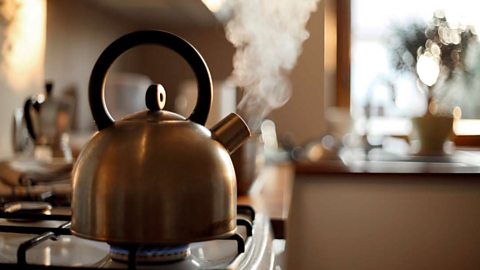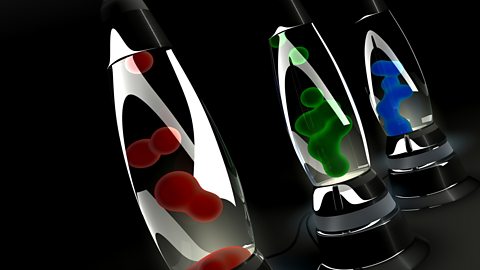Solids, liquids and gases
The kinetic particle theoryThe use of the arrangement and movement of particles to describe solids, liquids and gases. of matterSub-atomic particles and anything made from them, such as atoms and molecules, are matter. Energy and forces are not matter. is a model that describes the arrangement, movement and energythe capacity for doing work. of particleA general term for a small piece of matter. For example, protons, neutrons, electrons, atoms, ions or molecules. in a substance. The model is used to explain the physical propertiesA description of the appearance of a substance or how it acts without involving chemical reactions. For example, state, melting point, conductivity, etc. of solids, liquids and gases.
Particle arrangement and movement
The table below shows a comparison of the same substance in three different states.
The particles in the 2D diagrams could be atomAll elements are made of atoms. An atom consists of a nucleus containing protons and neutrons, surrounded by electrons., moleculeA cluster of atoms that are chemically bonded together in a fixed ratio. Molecules are always made from non-metal atoms. A molecule can be represented with a chemical formula, for example, O₂ or CH₄. or ionAn atom or molecule that has either a positive or negative electrical charge. depending on the type of substance, e.g. ionic compounds, small molecules, giant molecules, and metals.
Explaining properties
A single particle does not have the properties of the material it is part of. The properties of a substance are the properties of a huge number of particles together.
Solids:
- have a fixed shape and cannot flow, because their particles cannot move from place to place
- cannot be compressed (squashed), because their particles are close together and have no space to move into
Liquids:
- flow and take the shape of their container, because their particles can move around each other
- cannot be compressed, because their particles are close together and have no space to move into
Gases:
- flow and completely fill their container, because their particles can move quickly in all directions
- can be compressed. Particles are far apart and have space to move into
Podcast: States of matter
In this episode, Dr Sunayana Bhargava and Tulela Pea explore the states of matter: solid, liquid and gas. They define melting and freezing, and boiling and condensing points.
TULELA: I’m Tulela Pea, a science communicator and podcaster.
SUNAYANA: And I’m Dr Sunayana Bhargava, scientist and poet.
TULELA: And this is Bitesize Chemistry.
SUNAYANA: This is the seventh episode of an eight-part series on bonding, structure and properties. In this episode, we’re going to look at states of matter and changing states.
TULELA: Solids (the most dense state), liquids and gases (the least dense).
SUNAYANA: And looking at what’s going on according to the particle model. And we’ll be looking at how adding or taking energy away from a substance can convert it from one physical state to another.
TULELA: And dear podcast listening friends, grab some pen and paper and take some notes.
SUNAYANA: Look around you as you listen to this episode and everything you see, no matter where you are, is almost certainly in one of the three states of matter.
TULELA: Solid, liquid or gas.
SUNAYANA: In the Bitesize podcast studio, I can see solids which are tables, chairs, people and tea cups. But in the tea cup I can see a liquid, tea… and because the tea is still hot, I can see a gas, a trail of steam floating off into the air.
TULELA: We are so used to these three states of matter in our everyday lives, but what is going on in terms of chemistry and on a particle level – that’s what we’ll be looking after NNICK, our Bitesize binary-banter-bot, gives us a quick summary of model of matter. Hi NNICK. Can you tell us about the three states of matter accordingly to the particle model?
NNICK: People say to me, "NNICK, what's the matter?" "Oh," I reply, "the matter is a collection of atoms, and it's in one of three states; solid, liquid or gas." If you heat up a solid, it melts to become a liquid. If you heat up a liquid, it boils to become a gas. Conversely, if you cool down a gas, it condenses to become a liquid. If you cool down a liquid, it freezes to become a solid. How much energy it takes to change the state of a substance depends on the strength of the forces between its particles; the stronger the forces, the higher the melting and boiling points.
SONGHeat up a solid
It melts to become a liquid
Which can flow, but can't be compressed
Heat up a liquid
It boils to become a gas
Which can be compressed
Because each of its particles is further from the rest
Cool down a gas
It condenses to become a liquid
And now its particles have much less space
Cool down a liquid
It freezes to become a solid
Which can't flow in its space
Because each of its particles is fixed in its place
SUNAYANA: Thanks NNICK, so from what NNICK has summarised, we can visualise each individual molecule or ion or atom in the particle model as a solid sphere – like a snooker ball. And the properties of each state of matter depends on the forces between the particles.
TULELA: If we look at each in turn. In a solid, those particles are held together in a fixed rigid lattice by strong forces and each individual particle is in a low energy state.
SUNAYANA: In a snooker game, this is like the start of a game when all the red balls are tightly packed together within a triangular rack or frame with each ball touching its neighbours – no ball can swap position within the frame.
TULELA: Solids have a fixed shape and fixed volume and cannot be compressed because in this model, there is no space for the particles to move into. Let’s add some energy to the solid.
SUNAYANA: When we heat the solid, the particles gain more energy. They vibrate more and this weakens the bonds holding them together.
TULELA: In the snooker game, we’ve removed the triangular frame holding the balls rigid so that now the balls can jiggle around more and although they are free to roll around and move past each other, they do tend to stick together and remain in contact with each other.
SUNAYANA: The solid has become a liquid and the temperature at which this occurs is the melting point. Liquids don’t keep a definite shape, the particles are not in a fixed position but rather randomly arranged and they have greater energy than when they were in a solid.
TULELA: But like a solid, liquids still keep their same volume because, again, the particles are so close together that they have no space to move into. It’s like the tea in my cup, liquids flow to fill the bottom of a container. The reverse of melting, that is if we went from a liquid to a solid, is freezing.
SUNAYANA: OK. More heat, more energy. As we continue to heat our liquid, the particles move faster with more energy, weakening and breaking the bonds that hold them together, eventually overcoming the force of attraction holding them together. They are free to move, they spread out with higher energy. The liquid becomes a gas. And the temperature at which this happens is called the boiling point of the substance.
TULELA: Back on the snooker table, we can imagine this as the balls spreading out across the entire surface of the snooker table, bouncing off the cushions and each other with high speed.
SUNAYANA: Gas particles are spread out, move quickly in all directions at random and have the highest energy compared to particles in the solid and liquid states. Gases don’t keep a definite shape or volume and spread out to fill the entire space available to them, and so a gas can be compressed because the particle do have space to move into.
TULELA: A liquid becoming a gas happens at the boiling point of that liquid, but you may have heard the term evaporation which is closely connected. Both describe a liquid turning into a gas, but evaporation only happens at the surface of the liquid and can happen at any temperature.
SUNAYANA: Like the steam escaping from the top of my cup of tea.
TULELA: Whereas boiling only happens at the specific boiling point and happens throughout the entire liquid.
SUNAYANA: And the reverse of boiling – that is going back from a gas to a liquid – is called condensing.
TULELA: So quick summary, the melting point is the point at which a solid turns into a liquid if we’re heating it or a liquid becomes solid if we’re cooling it. And boiling point where a liquid changes into a gas if we’re heating it or a gas becomes a liquid if cooling.
SUNAYANA: And these points both relate directly to how strong the forces of attraction are between the particles. The stronger the force, the more energy is needed to break those bonds and so the higher the melting and boiling points are.
TULELA: If you remember from previous episodes, we saw in ionic compounds – like our friend sodium chloride - the strength of the bonds inside the ionic compound was comparatively higher than the forces between simple covalent compounds – like H2O water. And this is the reason why we found that ionic compounds have much higher melting and boiling points than simple covalent substances.
SUNAYANA: How about a states of matter example, Tulela?
TULELA: Why not indeed.
SUNAYANA: You might want to grab a pen and paper so you can write some of these numbers down. OK, so we can use the information about a substance’s melting and boiling point to predict what state it will be in at a particular temperature. If the temperature is lower than the melting point, it will be a solid. If the temperature is higher than boiling point, it will be a gas. And if the temperature is between the two, then it will be a liquid.
So I’ve got two substances here. Substance A has a melting point of minus 220 degrees Celsius and a boiling point of minus 183 degrees Celsius. And substance B has a melting point 800 degrees Celsius and a boiling point of 1400 degrees Celsius. What state of matter will each be at 1000 degrees Celsius? You can play along at home and no need to heat or cool anything with that information.
TULELA: OK – first one, substance A – melting point minus 220 degrees Celsius and boiling point minus 183 degrees Celsius. So both very low and much lower than the 1000 degrees Celsius. If we look at the boiling point, it’s lower than the temperature given so it must be a gas.
SUNAYANA: Correct.
TULELA: And substance B melting point 800 degrees Celsius, boiling point 1400 degrees Celsius and the temperature of 1000 degrees Celsius is between the two, so it must be a liquid.
SUNAYANA: Spot on.
TULELA: Summary time, Sunayana.
SUNAYANA: The three states of matter are solid, liquid and gas. Melting and freezing take place at the melting point, boiling and condensing take place at the boiling point.
TULELA: The amount of energy needed to change state from solid to liquid and from liquid to gas depends on the strength of the forces between the particles of the substance. The stronger the forces between the particles, the higher the melting point and boiling point of the substance and vice versa.
SUNAYANA: Solids have fixed shapes and cannot be compressed as the particles are not free to move.
TULELA: In liquids and gases the particles are free to move. A liquid takes the shape of its container and also cannot be compressed. And gases completely fill their container and can be compressed. And we can use information about a substances melting and boiling point to predict its state at any temperature.
SUNAYANA: As always there’s loads more guides to GCSE chemistry topics on the BBC Bitesize webpages.
TULELA: And you can listen on BBC Sounds to many other episodes in this or other podcast series of Bitesize chemistry with me, Tulela…
SUNAYANA: …And me, Sunayana. Your turn, Tulela.
[SOUND OF SNOOKER BALLS]
SUNAYANA: Good shot!
Changes of state
The diagram summarises the common changes of state.
Extended syllabus content
If you are studying the Extended syllabus, you will also need to know about forces and the distances between particles. Click 'show more' for this content:
Solids have strong bonds that hold them together. These stop the particles (atoms, molecules, ions or electrons) from moving, meaning solids retain their shape. The particles still vibrate but in a fixed position. Liquids have weaker forces between their particles, which allows them to move around each other and therefore flow. Gases have almost no forces between their particles, which also allows them to move around each other and flow.
Particle motion
The particles in a gas are moving very quickly in random directions. The speeds of the particles vary but, on average, they move quicker than they do in liquids and solids.
This means that it does not take long for a gas to spread out to fill its entire container. The smell of an air freshener can spread around a room very quickly.
Gas pressure
Since the particles in a gas are moving fast and randomly, collisions occur frequently. These collisions may be between two particles, between a particle and the wall of the container, or between a particle and something else in the container.
The force acting on the container due to these collisions is at right angles to the container.
For example, the collisions caused by a gas trapped inside a balloon cause forces to act outwards in all directions, giving the balloon its shape.
Pressure in gases
The pressure caused by a gas can be calculated using the equation:
\(pressure = \frac{force}{area}\)
This is when:
pressure (p) is measured in newtons per metre squared (N/m2)
force (F) is measured in newtons (N)
area (a) is measured in metres squared (m2)
Explaining change of state
Melting, evaporating and boiling
Energy must be transferred, by heating, to a substance for these changes of stateSolid, liquid or gas. Evaporation is a change of state from liquid to gas. to happen. During these changes the particles gain energy, which is used to:
- break some of the bondThe chemical link that holds molecules together. between particles during meltingThe process that occurs when a solid turns into a liquid when it is heated.
- overcome the remaining forces of attraction between particles during evaporationThe process in which a liquid changes state and turns into a gas. or boilChanging from the liquid to the gas state, in which bubbles of gas form throughout the liquid.
In evaporation, particles leave a liquid from its surface only.
In boiling, bubbles of gas form throughout the liquid. They rise to the surface and escape to the surroundings, forming a gas.
The amount of energy needed to change state from solid to liquid, and from liquid to gas, depends on the strength of the forces between the particles of a substance. The stronger the forces of attraction, the more energy is required.
Every substance has its own melting point and boiling point. The stronger the forces between particles, the higher its melting and boiling points.
The strength of the forces between particles depends on the particles involved. For example, the forces between ions in an ionic solid are stronger than those between molecules in water or hydrogen.
Evaporation can take place below the boiling point of a substance.
Condensing and freezing
Energy is transferred from a substance to the surroundings when a substance condenses or freezes. This is because the forces of attraction between the particles get stronger.
Video: The atomic structure of metal
Mark Miodownik uses a computer animation to outline the lattice arrangement of atoms in solid metals - a configuration that makes metals both malleable and strong.
Diffusion
Video: Movement of particles
Watch this video that explores how the movement of particles and gases causes diffusion.
You walk into a coffee shop and immediately smell coffee. Why?
One reason is moving air currents or convection. Moving currents of air carry coffee smell particles around the coffee shop.
But even without convection, the smell would still reach you eventually - by diffusion. In diffusion, coffee particles move from the coffee machine (an area of high concentration) to the rest of the coffee shop (an area of low concentration).
Diffusion is the particles of one substance spreading out and mixing with the particles of another substance.
Making a cup of coffee also involves the diffusion of coffee particles through hot water:

Image caption, 1. Highly concentrated coffee molecules enter the cup of hot water.

Image caption, 2. Coffee molecules begin to spread out in between the water molecules.

Image caption, 3. Coffee molecules, now evenly dispersed through the water, are in a lower concentration than they started in.
1 of 3
In gases and liquids, particles move randomly from place to place. The particles collide with each other or with their container. This makes them change direction. Eventually, the particles are spread through the whole liquid or whole container.
Brownian motion
Gas particles move very quickly - particles in air move at 500 m/s on average, at room temperature. However, the particles of a smell do not travel this fast. This is because its particles collide with each other and with particles of air very frequently. They change direction randomly when they collide, so it takes much longer to travel from one place to another. Their random motion because of collisions is called Brownian motionThe random motion of microscopic particles suspended in a gas or liquid as a result of collisions.
In this example, the particles of the smell are suspended in the particles of the air. Brownian motion also occurs in particles of a solid suspended in a liquid. An example of this is pollen grains suspended in water. The pollen grains can be observed moving in random directions using a light microscope.
Brownian provides evidence for the kinetic particle model of matter.
Extended syllabus content
If you are studying the Extended syllabus, you will also need to know more about Brownian motion. Click 'show more' for this content:
The microscopic particles that are observed in Brownian motion can be moved by collisions with the lighter, faster moving molecules that surround them. These have little mass but move at a high speed. This means they have a large momentum and collide with a large force. They are therefore capable of moving much larger molecules suspended around them when they collide.
Pressure and temperature
If the volumeThe volume of a three-dimensional shape is a measure of the amount of space or capacity it occupies, eg an average can of fizzy drink has a volume of 330 ml. of a container with a gas inside stays the same, the pressure of a gas increases as its temperatureHow warm or cold something is. increases.
Key fact: The temperature of a gas is a measure of the average Kinetic energyEnergy which an object possesses by being in motion. of its particles - the higher the temperature, the higher the average kinetic energy.
As a result, the gas particles will be travelling faster and will collide with the walls of the container more frequently, and with more force.
This means that there is a relationship between pressureForce exerted over an area. The greater the pressure, the greater the force exerted over the same area. and temperature. If a pressure gauge is connected to a flask of air and the flask is heated, a graph of pressure against temperature can be produced.
As the temperature increases, the pressure increases showing that pressure is directly proportionalA relationship between two variables, eg in a gas. As temperature increases, the pressure would also increase proportionally. (If the temperature doubled, the pressure would double). to temperature.
Pressure and volume
If a balloon is squeezed it will get smaller. If the pressure is increased, the volume will decrease.
The Irish scientist Robert Boyle originally investigated this relationship in the 17th century. Boyle carried out an experiment that gave one of the first pieces of experimental evidence for the particle theory.
By pouring mercury into a J-shaped tube that was sealed at one end, Boyle was able to trap a bubble of air. He then poured more mercury in slowly and watched what happened to the volume of the air bubble.
The higher the column of mercury in the left hand side of the tube, the greater the pressure the trapped air was experiencing and the smaller the bubble became.
Key fact: Boyle was able to show that volume is inverse proportionTwo variables multiply to give a fixed product. When one variable doubles, the other halves. to pressure.
Extended syllabus content
If you are studying the Extended syllabus, you will also need to know more about mass at a constant temperature. Click 'show more' for this content:
For a fixed mass of gas at a constant temperature:
pressure × volume = constant
\(p~V = constant\)
This is when:
- pressure (p) is measured in pascals (Pa)
- volume (V) is measured in metres cubed (m3)
If the temperature of a gas stays the same, the pressure of the gas increases as the volume of its container decreases. This is because the same number of particles collide with the walls of the container more frequently as there is less space. However, the particles still collide with the same amount of force.
The change in volume or pressure for gas at a constant temperature can be calculated using the equation:
\(p_1 V_1 = p_2 V_2\)
p1 and V1 are the pressure and volume before either are changed, p2 and V2 are the pressure and volume after the change.
Example
A gas occupies a volume of 0.50 m³ at a pressure of 100 Pa. Calculate the pressure exerted by the gas if it is compressed to a volume of 0.25 m³. Assume that the temperature and mass of the gas stay the same.
Rearrange \(p_1 V_1 = p_2 V_2\) to find p2:
\(p_2 = \frac{p_1 \times v_1}{V_2}\)
\(p_2 = \frac{100 \times 0.50}{0.25}\)
New pressure: p2 = 200 Pa
Question
If a gas has a pressure of 200,000 Pa when it is in a volume of 10 m3, what will its pressure be if the volume is reduced to 2.5 m3?
Rearrange p1 V1 = p2 V2 to find p2:
\(p2 = \frac{p1 \times V1}{V2}\)
\(p2 = \frac{200,000 \times 10}{2.5}\)
New pressure: \(p_2 = 800,000~Pa\) or \(800~kPa\)
Kinetic energy, temperature and the Kelvin scale
Video: Kinetic theory
Pressure, temperature and volume of gas explained using gas laws and the kinetic model
Imagine a gas is trapped inside a container which has a fixed size (its volume cannot change). Gas pressure is caused by the collisions of the gas particles with the inside of the container as they collide with and exert a force on the container walls. Then the gas is heated up.
As the temperature of the gas increases, the particles gain kinetic energy and their speed increases. This means that the particles hit the sides more often and with greater force. Both of these factors cause the pressure of the gas to increase.
A temperature of absolute zero is the point at which the gas particles stop moving. This corresponds to a temperature of \(-273^{\circ}C \). Particles have no kinetic energy at all so no energy can be removed and the temperature cannot get any lower. With no kinetic energy and now stationary, the particles will exert no pressure either.
Using this idea of absolute zeroA temperature where the kinetic energy of a particle is zero, eg absolute zero has a temperature of 0 K., it makes sense to create a new temperature scale – one where 'zero' is 'absolute zero'.
To convert °C into K, add 273.
To convert K into °C, subtract 273.
Quiz
Test your knowledge of particles with this quiz.
More on Thermal physics
Find out more by working through a topic
- count2 of 4

- count3 of 4

- count4 of 4
